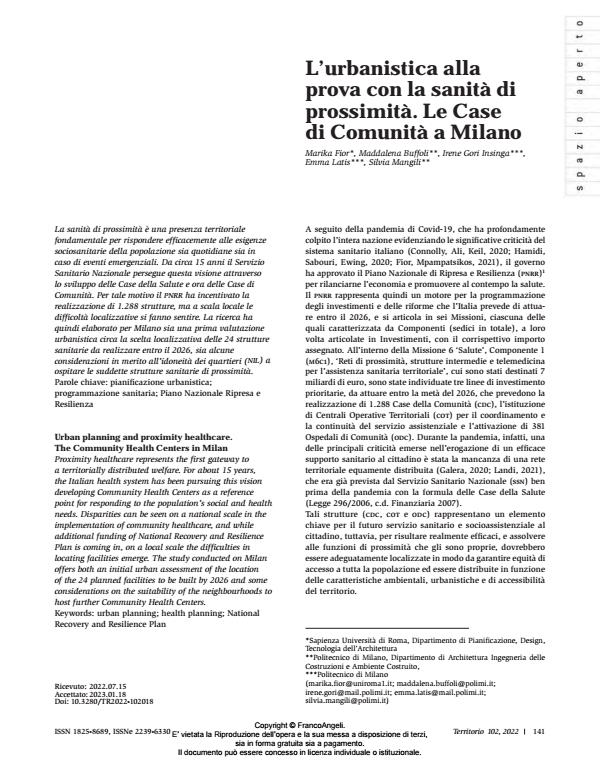Urban planning and proximity healthcare. The Community Health Centers in Milan
Journal title TERRITORIO
Author/s Marika Fior, Maddalena Buffoli, Irene Gori Insinga, Emma Latis, Silvia Mangili
Publishing Year 2023 Issue 2022/102 Language Italian
Pages 11 P. 141-151 File size 345 KB
DOI 10.3280/TR2022-102018
DOI is like a bar code for intellectual property: to have more infomation
click here
Below, you can see the article first page
If you want to buy this article in PDF format, you can do it, following the instructions to buy download credits

FrancoAngeli is member of Publishers International Linking Association, Inc (PILA), a not-for-profit association which run the CrossRef service enabling links to and from online scholarly content.
Proximity healthcare represents the first gateway to a territorially distributed welfare. For about 15 years, the Italian health system has been pursuing this vision developing Community Health Centers as a reference point for responding to the population’s social and health needs. Disparities can be seen on a national scale in the implementation of community healthcare, and while additional funding of National Recovery and Resilience Plan is coming in, on a local scale the difficulties in locating facilities emerge. The study conducted on Milan offers both an initial urban assessment of the location of the 24 planned facilities to be built by 2026 and some considerations on the suitability of the neighbourhoods to host further Community Health Centers.
Keywords: urban planning; health planning; National Recovery and Resilience Plan
- Bertani D., 2021, «Case e Ospedali di comunità: parte da Milano ‘modello’ sanità di prossimità». Lombardia Notizie Online, 6 settembre. -- www.lom- bardianotizie.online/case-ospedali-di-comunita/ (accesso: 2022.07.13). Buffoli M., 2014, Urban Health: strategie per la sostenibilità urbana. Milano: FrancoAngeli.
- Capolongo S., Rebecchi A., Buffoli M., Appolloni L., Signorelli C., Fara G.M., D’Alessandro D., 2020, «COVID-19 and Cities: from Urban Health strategies to the pandemic challenge. A Decalogue of Public Health op- portunities». Acta Biomed, 91, 2: 13-22.
- Connolly C., Ali S.H., Keil R., 2020, «On the relationships between COVID-19 and extended urbanization». Geography, Urban Studies & Planning, 10, 2: 213–216. DOI: 10.1177/2043820620934209
- Dell’Ovo M., Oppio A., Capolongo S., 2020, Decision support system for the location of healthcare facilities. SitHealth evaluation tool. Cham: SpringerBriefs.
- Deloitte, 2020, Outlook Salute 2021 – Il Sistema Sanitario Italiano tra pubblico e privato: sostenibilità e prospettive, 22 gennaio 2022. -- www2. deloitte.com/it/it/pages/public-sector/articles/deloitte-outlook-salu- te-italia-2021---deloitte-italy---public.html (accesso: 2022.07.13).
- Fior M., Mpampatsikos V., 2021, «COVID-19 and estimates of actual deaths in Italy. Scenarios for urban planning in Lombardy». Journal of Urban Management, 10, 3: 275-301.
- Galera G., 2020, «Verso un sistema sanitario di comunità. Il contributo del terzo settore». Impresa sociale, II, 16 settembre 2021. -- www.rivistaim- presasociale.it/rivista/articolo/verso-un-sistema-sanitario-di-comunita (accesso: 2022.07.13).
- Hamidi S., Sabouri S., Ewing R., 2020. «Does Density Aggravate the COVID-19 Pandemic?: Early Findings and Lessons for Planners». Journal of American Planning Association, 86, 4: 495-509. DOI: 10.1080/01944363.2020.1777891
- Landi S., 2021, «Covid Lombardia, ospedali sotto stress: reparti convertiti e pazienti lievi che intasano i Pronto Soccorso». Corriere della Sera, 20 ottobre 2021. -- https://milano.corriere.it/notizie/cronaca/21_marzo_04/ covid-lombardia-ospedali-sotto-stress-reparti-convertiti-pazienti-lie-vi-che-intasano-pronto-soccorso-d5244384-7c5c-11eb-bc48-454ef- d4893c8.shtml (accesso: 2022.07.13).
- Manzini E., 2021, Abitare la prossimità, idee per la città dei 15 minuti. Milano: Egea.
- Moreno C., 2020, «Vie urbaine et proximité à l’heure du Covid-19». Paris: Editions de l’Observatoire.
- Ravizza S., 2020, «L’Istituto dei tumori trasloca a Sesto (tra 7 anni): ‘Rin- noviamo la sede’». Corriere della Sera. Cronaca di Milano, 27 gennaio. -- https://milano.corriere.it/notizie/cronaca/20_gennaio_27/istituto-tu- mori-trasloca-sesto-tra-7-anni-rinnoviamo-sede-6af5e69a-406a-11e- a-a133-84fd84fc9cfa.shtml (accesso: 2022.07.13).
- Ugolini M., 2022, «Case della Salute: condizioni di fragilità e occasioni di rigenerazione sociale e urbana». Territorio, 97-Supplemento: 147-153. Supplementooa12939.
- Zanella R., 2022, La sanità di prossimità. Case della salute, ospedali di comunità, farmacie multi-servizi nelle ‘città dei quindici minuti’. Roma: Il Pensiero Scientifico Editore.
Marika Fior, Maddalena Buffoli, Irene Gori Insinga, Emma Latis, Silvia Mangili, L’urbanistica alla prova con la sanità di prossimità. Le Case di Comunità a Milano in "TERRITORIO" 102/2022, pp 141-151, DOI: 10.3280/TR2022-102018